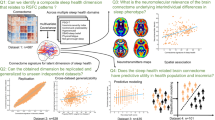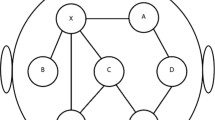Abstract
Sleep disorders affect more than one-quarter of the world's population, resulting in reduced daytime productivity, impaired immune function, and an increased risk of cardiovascular disease. It is important to identify the physiological and psychological factors related to sleep for the prevention and treatment of sleep disorders. In this study, we correlated measurements of emotional state, sleep quality, and some brain neural activity parameters to better understand the brain and psychological factors related to sleep. Resting-state functional magnetic resonance imaging (rs-fMRI) of 116 healthy undergraduates were analyzed using graph theory to assess regional topological characteristics. Among these, the left thalamic cluster coefficient proved to be the ablest to reflect the characteristics of the sleep neural graph index. The Profile of Mood States (POMS) was used to measure vigor, and the Pittsburgh Sleep Quality Index (PSQI) to assess sleep quality. The results showed that the left thalamic clustering coefficient was negatively correlated with sleep quality and vigor. Further, the left thalamic clustering coefficient moderated the relationship between vigor and sleep quality. When the left thalamic clustering coefficient was very low, there was a significant positive correlation between vigor and sleep quality. However, when the left thalamic clustering coefficient was high, the correlation between vigor and sleep quality became insignificant. The relationship between vigor and sleep quality is heterogeneous. Analyzing the function of the left thalamic neural network could help understand the variation in the relationship between vigor and sleep quality in different populations. Such observations may help in the development of personalized interventions for sleep disorders.

Similar content being viewed by others
Change history
12 July 2023
A Correction to this paper has been published: https://doi.org/10.1007/s41105-023-00474-0
References
Streatfeild J, Smith J, Mansfield D, Pezzullo L, Hillman D. The social and economic cost of sleep disorders. Sleep. 2021;44(11):zsab132.
Nelson KL, Davis JE, Corbett CF. Sleep quality: an evolutionary concept analysis. Nurs Forum. 2022;57(1):144–51.
Wang F, Bíró É. Determinants of sleep quality in college students: a literature review. Explore. 2021;17(2):170–7.
Kontou TG, Sargent C, Roach GD. A week of sleep restriction does not affect nighttime glucose concentration in healthy adult males when slow-wave sleep is maintained. Sensors (Basel, Switzerland). 2022;22(18):6962.
Ong AD, Kim S, Young S, Steptoe A. Positive affect and sleep: a systematic review. Sleep Med Rev. 2017;35:21–32.
Ryan RM, Frederick C. On energy, personality, and health: subjective vigor as a dynamic reflection of well-being. J Pers. 1997;65(3):529–65.
Brellenthin AG, Crombie KM, Hillard CJ, Brown RT, Koltyn KF. Psychological and endocannabinoid responses to aerobic exercise in substance use disorder patients. Substance Abuse. 2021;42(3):272–83.
Chtourou H, Trabelsi K, Ammar A, Shephard RJ, Bragazzi NL. Acute effects of an “energy drink” on short-term maximal performance, reaction times, psychological and physiological parameters: Insights from a randomized double-blind, placebo-controlled, counterbalanced crossover trial. Nutrients. 2019;11(5):992.
Kirn DR, Koochek A, Reid KF, von Berens Å, Travison TG, Folta S, Sacheck J, Nelson M, Liu C, Phillips E, Åberg AC, Nydahl M, Gustafsson T, Cederholm T, Fielding RA. The vitality, independence, and vigor in the elderly 2 study (VIVE2): design and methods. Contemp Clin Trials. 2015;43:164–71.
Armon G, Melamed S, Vinokur A. The reciprocal relationship between vigor and insomnia: a three-wave prospective study of employed adults. J Behav Med. 2014;37(4):664–74.
Costa C, Teodoro M, Briguglio G, Vitale E, Giambò F, Indelicato G, et al. Sleep quality and mood state in resident physicians during COVID-19 pandemic. Int J Environ Res Public Health. 2021;18(15):8023.
Fukuda T, Akiyama S, Takahashi K, Iwadate Y, Ano Y. Effect of non-alcoholic beer containing matured hop bitter acids on mood states in healthy adults: a single-arm pilot study. Nurs Health Sci. 2022;24(1):7–16.
Ward-Ritacco CL, Adrian AL, O’Connor PJ, Binkowski JA, Rogers LQ, Johnson MA, Evans EM. Feelings of energy are associated with physical activity and sleep quality, but not adiposity, in middle-aged postmenopausal women. Menopause. 2015;22(3):304–11.
Wenzel JA, Griffith KA, Shang J, Thompson CB, Hedlin H, Stewart KJ, et al. Impact of a home-based walking intervention on outcomes of sleep quality, emotional distress, and fatigue in patients undergoing treatment for solid tumors. Oncologist. 2013;18(4):476–84.
Whalley K. Too excited to sleep. Nat Rev Neurosci. 2022;23(5):254–5.
Dickman SJ. Dimensions of arousal: wakefulness and vigor. Hum Factors. 2002;44(3):429–42.
Gent TC, Bassetti CL, Adamantidis AR. Sleep-wake control and the thalamus. Curr Opin Neurobiol. 2018;52:188–97.
Masuda N, Sakaki M, Ezaki T, Watanabe T. Clustering coefficients for correlation networks. Front Neuroinform. 2018;12:7.
Smitha KA, Akhil Raja K, Arun KM, Rajesh PG, Thomas B, Kapilamoorthy TR, Kesavadas C. Resting state fMRI: a review on methods in resting state connectivity analysis and resting state networks. Neuroradiol J. 2017;30(4):305–17.
Xue S, Tang YY, Posner MI. Short-term meditation increases network efficiency of the anterior cingulate cortex. NeuroReport. 2011;22(12):570–4.
Sporns O. Graph theory methods: applications in brain networks. Dialogues Clin Neurosci. 2018;20(2):111–21.
Fornito A, Zalesky A, Breakspear M. Graph analysis of the human connectome: promise, progress, and pitfalls. Neuroimage. 2013;80:426–44.
Zhang J, Liu L, Li H, Feng X, Zhang M, Liu L, Meng X, Ding G. Large-scale network topology reveals brain functional abnormality in Chinese dyslexic children. Neuropsychologia. 2021;157: 107886.
Li T, Xie Y, Tao S, Yang Y, Xu H, Zou L, et al. Chronotype, sleep, and depressive symptoms among Chinese college students: a cross-sectional study. Front Neurol. 2020. https://doi.org/10.3389/fneur.2020.592825.
Ding X, Wang X, Yang Z, Tang R, Tang YY. Relationship between trait mindfulness and sleep quality in college students: a conditional process model. Front Psychol. 2020. https://doi.org/10.3389/fpsyg.2020.576319.
Patriat R, Molloy EK, Meier TB, Kirk GR, Nair VA, Meyerand ME, Prabhakaran V, Birn RM. The effect of resting condition on resting-state fMRI reliability and consistency: a comparison between resting with eyes open, closed, and fixated. Neuroimage. 2013;78:463–73.
Watts DJ, Strogatz SH. Collective dynamics of ‘small-world’ networks. Nature. 1998;393:440–2.
James LR, Brett JM. Mediators, moderators, and tests for mediation. J Appl Psychol. 1984;69(2):307.
Grandner MA. Sleep, health, and society. Sleep Med Clin. 2017;12(1):1–22.
Farahani FV, Karwowski W, D’Esposito M, Betzel RF, Douglas PK, Sobczak AM, Bohaterewicz B, Marek T, Fafrowicz M. Diurnal variations of resting-state fMRI data: a graph-based analysis. Neuroimage. 2022;256: 119246.
McKinnon AC, Lagopoulos J, Terpening Z, Grunstein R, Hickie IB, Batchelor J, Lewis SJ, Duffy S, Shine JM, Naismith SL. Sleep disturbance in mild cognitive impairment is associated with alterations in the brain’s default mode network. Behav Neurosci. 2016;130(3):305–15.
Pini L, Wennberg A, Mitolo M, Meneghello F, Burgio F, Semenza C, Venneri A, Mantini D, Vallesi A. Quality of sleep predicts increased frontoparietal network connectivity in patients with mild cognitive impairment. Neurobiol Aging. 2020;95:205–13.
Wang Y, Li J, Zeng L, Wang H, Yang T, Shao Y, Weng X. Open eyes increase neural oscillation and enhance effective brain connectivity of the default mode network: resting-state electroencephalogram research. Front Neurosci. 2022;16: 861247.
Li M, Wang R, Zhao M, Zhai J, Liu B, Yu D, Yuan K. Abnormalities of thalamus volume and resting state functional connectivity in primary insomnia patients. Brain Imaging Behav. 2019;13(5):1193–201.
Zhang J, Liu L, Li H, Feng X, Zhang M, Liu L, et al. Large-scale network topology reveals brain functional abnormality in Chinese dyslexic children. Neuropsychologia. 2021;157: 107886.
Gaidica M, Hurst A, Cyr C, Leventhal DK. Distinct populations of motor thalamic neurons encode action initiation, action selection, and movement vigor. J Neurosci. 2018;38(29):6563–73.
Hamani C, Dostrovsky JO, Lozano AM. The motor thalamus in neurosurgery. Neurosurgery. 2006;58(1):146–58.
Caeyenberghs K, Verhelst H, Clemente A, Wilson PH. Mapping the functional connectome in traumatic brain injury: what can graph metrics tell us? Neuroimage. 2017;160:113–23.
Le Masson G, Masson RL, Debay D, Bal T. Feedback inhibition controls spike transfer in hybrid thalamic circuits. Nature. 2002;417(6891):854–8.
Zhao X, Kim JW, Robinson PA. Slow-wave oscillations in a corticothalamic model of sleep and wake. J Theor Biol. 2015;370:93–102.
Kilic H, Yilmaz K, Asgarova P, Kizilkilic O, Hatay GH, Ozturk-Isik E, et al. Electrical status epilepticus in sleep: the role of thalamus in etiopathogenesis. Seizure. 2021;93:44–50.
Gordji-Nejad A, Matusch A, Li S, Kroll T, Beer S, Elmenhorst D, Bauer A. Phosphocreatine levels in the left thalamus decline during wakefulness and increase after a nap. J Neurosci. 2018;38(49):10552–65.
Acknowledgements
We thank all students who participated in this research.
Funding
This research was supported by funding from the Youth Foundation for Humanities and Social Sciences Research of the Ministry of Education (21YJC190004). The study does not necessarily reflect the opinions or views of the funding sources. The funder had no role in the design and conduct of the study; collection, management, analysis, and interpretation of the data; preparation, review, or approval of the manuscript; and decision to submit the manuscript for publication.
Author information
Authors and Affiliations
Corresponding authors
Ethics declarations
Conflict of interest
The authors declare that they have no conflict of interest.
Additional information
Publisher's Note
Springer Nature remains neutral with regard to jurisdictional claims in published maps and institutional affiliations.
The original online version of this article was revised to update the conflict of interest statement.
Rights and permissions
Springer Nature or its licensor (e.g. a society or other partner) holds exclusive rights to this article under a publishing agreement with the author(s) or other rightsholder(s); author self-archiving of the accepted manuscript version of this article is solely governed by the terms of such publishing agreement and applicable law.
About this article
Cite this article
Ding, X., Li, Q. & Tang, YY. The thalamic clustering coefficient moderates the vigor–sleep quality relationship. Sleep Biol. Rhythms 21, 369–375 (2023). https://doi.org/10.1007/s41105-023-00456-2
Received:
Accepted:
Published:
Issue Date:
DOI: https://doi.org/10.1007/s41105-023-00456-2




